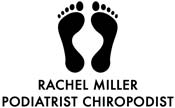In-toeing, Out-toeing, Toe walking, Curly toes
For most children, it is normal for them to present with in-toeing, out-toeing, toe walking or curly toes. These conditions often correct themselves. However, If your child seems to be in pain, frequently trips, or you have concerns about their development, an assessment from an experienced podiatrist can help diagnose if there is a problem and suggest a treatment plan.
Rachel Miller is a highly experienced podiatrist who sees many children who have the conditions in-toeing, out-toeing, toe walking or curly toes. Please see below if you want more detailed explanation of these conditions.
Call 020 8348 5553 to make an appointment
In-toeing, Out-toeing, Toe Walking, Curly Toes
In-toeing
In-toeing, also known as pigeon toes, is when the foot turns inwards and can affect one or both feet. Your child may limp, stumble or trip during running or walking. In most cases, this condition will improve with maturity and does not require treatment.
There are 3 types of in-toeing and their exact causes is not fully understood:
- Curved foot (metatarsus adductus), which is usually present at birth.
- Twisted shin (tibia torsion), is the most common cause of in-toeing, which usually occurs around the ages of 1 to 3.
- Twisted thighbone (femoral anteversion), which occurs around the ages of 3 to 8.
If in-toeing continues, it should be evaluated by an experienced podiatrist. In-toeing can potentially lead to foot deformities such as bunions, hammertoe and flat feet. In rare cases, it may be a sign of other, more serious conditions such as neurological or genetic disorders.
The treatment approach will depend on the specific cause and type of in-toeing and may involve:
- advice about activities which may help improve the condition
- postural advice
- footwear advice
- an orthotic insole can be prescribed.
Out-toeing
Out-toeing refers to the condition when one or both feet point outwards. Out-toeing does not often cause pain but may result in difficulty walking and running. In most cases, out-toeing does not require treatment.
The majority of cases occur due to the rotation of either the thigh bone or the shin bone.
Occasionally, out-toeing is caused by a condition called developmental dysplasia of the hip, a dislocation of the hip joint, especially if only one foot is in an out-toed position. This condition should be evaluated by an experienced podiatrist.
Toe walking
Toe walking is common and children from around 10 months onward can walk on tip toes. This behavior may continue for some years and in most cases there are no identifiable reasons but possible underlying causes can include:
- short calf muscles
- habit, a child gets used to tip toe walking
- a child enjoys the sensation of being on their toes or dislikes the sensation of their feet touching the ground
- toe walking can have an underlying cause, such as a congenital tightness of muscle, a neurological or developmental issue
Some children, if they continue with toe walking, develop stiffness, tightening and pain in their Achilles tendon. An assessment from an experienced podiatrist may help find any underlying cause for toe walking.
Treatment for toe walking can include:
- stretching exercises can help alleviate symptoms
- activities and exercises to help strengthen muscles
- footwear advice
- an orthotic insole.
Curly toes
Curly toes are a common condition that is often present at birth. They typically affect the 3rd, 4th and 5th toe of one or both feet.
The underlying cause for curly toes is the tendons, that bend the toes, are too tight. The exact reason for this tightness is not completely understood, the shape of the toe bone may be relevant and the condition could be inherited.
For the majority of people curly toes do not cause a problem. However, some people may experience sores, blisters, hard skin or some pain in their feet. Choosing the right shoes can be a difficulty.
To alleviate symptoms and manage curly toes effectively, an assessment with an experienced podiatrist can be helpful. You might be provided guidance on appropriate stretching exercises and offered advice on choosing suitable footwear to address any discomfort associated with curly toes.
Contact the Centre for an appointment on 020 8348 5553
Rachel Miller is a highly experienced podiatrist specialising in biomechanics and orthotic insoles who sees many children with the conditions in-toeing, out-toeing, toe walking or curly toes. Her clinic, Highgate Podiatry, is in Highgate Village, 14 Pond Square, N6 6BA, London. Clinics are held every Sunday, Wednesday and Thursday. Please contact the clinic for an appointment on 020 8348 5553. For the clinic’s address, map and directions see the Contact page and for information about orthotic insoles and biomechanics see the Biomechanics page.
Conditions that can benefit from a biomechanical assessment include:
- Heel pain
- Ankle injuries
- Metatarsalgia
- Sports injuries
- Bunions
- Plantar fasciitis
- Hypermobility
- Flat feet/high arches
- Achilles tendinopathy
- Overuse injuries
- Knee pain
- Back pain
- Sprained ankles
- Stress fractures
- Tarsal tunnel syndrome
- Morton’s neuroma
- Heel pad syndrome
- Haglund’s deformity
- Hammer toe and mallet toe
- Sever’s disease
- Patellofemoral pain syndrome
- Patella Tendinopathy
- Osgood-Schlatter disease






